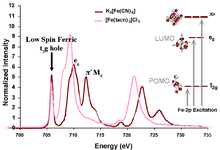
Metal L-edge spectroscopy is a spectroscopic technique used to study the electronic structures of transition metal atoms and complexes. This method measures X-ray absorption caused by the excitation of a metal 2p electron to unfilled d orbitals (e.g. 3d for first-row transition metals), which creates a characteristic absorption peak called the L-edge. Similar features can also be studied by Electron Energy Loss Spectroscopy. According to the selection rules, the transition is formally electric-dipole allowed, which not only makes it more intense than an electric-dipole forbidden metal K pre-edge (1s → 3d) transition, but also makes it more feature-rich as the lower required energy (~400-1000 eV from scandium to copper) results in a higher-resolution experiment.
In the simplest case, that of a cupric (Cu) complex, the 2p → 3d transition produces a 2p3d final state. The 2p core hole created in the transition has an orbital angular momentum L=1 which then couples to the spin angular momentum S=1/2 to produce J=3/2 and J=1/2 final states. These states are directly observable in the L-edge spectrum as the two main peaks (Figure 1). The peak at lower energy (~930 eV) has the greatest intensity and is called the L3-edge, while the peak at higher energy (~950 eV) has less intensity and is called the L2-edge.
Spectral components

As we move left across the periodic table (e.g. from copper to iron), we create additional holes in the metal 3d orbitals. For example, a low-spin ferric (Fe) system in an octahedral environment has a ground state of (t2g)(eg) resulting in transitions to the t2g (dπ) and eg (dσ) sets. Therefore, there are two possible final states: t2geg or t2geg(Figure 2a). Since the ground-state metal configuration has four holes in the eg orbital set and one hole in the t2g orbital set, an intensity ratio of 4:1 might be expected (Figure 2b). However, this model does not take into account covalent bonding and, indeed, an intensity ratio of 4:1 is not observed in the spectrum.
In the case of iron, the d excited state will further split in energy due to d-d electron repulsion (Figure 2c). This splitting is given by the right-hand (high-field) side of the d Tanabe–Sugano diagram and can be mapped onto a theoretical simulation of a L-edge spectrum (Figure 2d). Other factors such as p-d electron repulsion and spin-orbit coupling of the 2p and 3d electrons must also be considered to fully simulate the data.
For a ferric system, all of these effects result in 252 initial states and 1260 possible final states that together will comprise the final L-edge spectrum (Figure 2e). Despite all of these possible states, it has been established that in a low-spin ferric system, the lowest energy peak is due to a transition to the t2g hole and the more intense and higher energy (~3.5 eV) peak is to that of the unoccupied eg orbitals.
Feature mixing

In most systems, bonding between a ligand and a metal atom can be thought of in terms of metal-ligand covalent bonds, where the occupied ligand orbitals donate some electron density to the metal. This is commonly known as ligand-to-metal charge transfer or LMCT. In some cases, low-lying unoccupied ligand orbitals (π*) can receive back-donation (or backbonding) from the occupied metal orbitals. This has the opposite effect on the system, resulting in metal-to-ligand charge transfer, MLCT, and commonly appears as an additional L-edge spectral feature.
An example of this feature occurs in low-spin ferric , since CN is a ligand that can have backbonding. While backbonding is important in the initial state, it would only warrant a small feature in the L-edge spectrum. In fact, it is in the final state where the backbonding π* orbitals are allowed to mix with the very intense eg transition, thus borrowing intensity and resulting in the final dramatic three peak spectrum (Figure 3 and Figure 4).
Model construction

X-ray absorption spectroscopy (XAS), like other spectroscopies, looks at the excited state to infer information about the ground state. To make a quantitative assignment, L-edge data is fitted using a valence bond configuration interaction (VBCI) model where LMCT and MLCT are applied as needed to successfully simulate the observed spectral features. These simulations are then further compared to density functional theory (DFT) calculations to arrive at a final interpretation of the data and an accurate description of the electronic structure of the complex (Figure 4).
In the case of iron L-edge, the excited state mixing of the metal eg orbitals into the ligand π* make this method a direct and very sensitive probe of backbonding.
See also
References
- Westre, Tami E.; Kennepohl, Pierre; DeWitt, Jane G.; Hedman, Britt; Hodgson, Keith O.; Solomon, Edward I. (July 1997). "A Multiplet Analysis of Fe K-Edge 1s → 3d Pre-Edge Features of Iron Complexes". Journal of the American Chemical Society. 119 (27): 6297–6314. doi:10.1021/ja964352a.
- Cramer, S. P.; DeGroot, F. M. F.; Ma, Y.; Chen, C. T.; Sette, F.; Kipke, C. A.; Eichhorn, D. M.; Chan, M. K.; Armstrong, W. H. (October 1991). "Ligand field strengths and oxidation states from manganese L-edge spectroscopy". Journal of the American Chemical Society. 113 (21): 7937–7940. doi:10.1021/ja00021a018.
- ^ Wasinger, Erik C.; de Groot, Frank M. F.; Hedman, Britt; Hodgson, Keith O.; Solomon, Edward I. (October 2003). "L-edge X-ray Absorption Spectroscopy of Non-Heme Iron Sites: Experimental Determination of Differential Orbital Covalency". Journal of the American Chemical Society. 125 (42): 12894–12906. doi:10.1021/ja034634s. hdl:1874/26050. PMID 14558838. S2CID 5964786.
- ^ Hocking, Rosalie K.; Wasinger, Erik C.; de Groot, Frank M. F.; Hodgson, Keith O.; Hedman, Britt; Solomon, Edward I. (August 2006). "Fe L-Edge XAS Studies of K4 and K3: A Direct Probe of Back-Bonding". Journal of the American Chemical Society. 128 (32): 10442–10451. doi:10.1021/ja061802i. hdl:1874/20153. PMID 16895409.